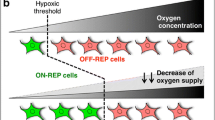Summary
The kidney is the main site of erythropoietin (EPO) formation. Oxygen sensing in the kidney itself plays a major role in the control of EPO synthesis. By in situ hybridization it has been established that the EPO-producing cells are situated in the interstitium of the cortical labyrinth, but they have not been precisely identified. Morphological findings provide new insights into the location and mechanism of oxygen sensing in the kidney. In addition to causing an increase in the number of cells containing EPO messenger RNA, anemia provokes structural changes exclusively in the cortical labyrinth. Specifically, the fibroblasts become enlarged and show increased activity of 5′-nucleotidase, and the S1 segment of the proximal tubule shows similar alterations as in various models of hypoxia. Thus, structures that are situated in the close vicinity of the EPO-producing cells appear to be sensitive to decreased oxygen delivery.
Similar content being viewed by others
Abbreviations
- EPO:
-
erythropoietin
- MHC II:
-
major histocompatibility class II antigen
- PAS:
-
Period-acid-Schiff reaction
- S1:
-
first segment of proximal tubule
- S2:
-
second segment of proximal tubule
References
Bohman S-O, Sundelin B, Forsum U, Tribukait B (1988) Experimental depletion of different renal interstitial cell populations. Am J Med Sci 295:252–257
Dobyan DC, Nagle RB, Bulger RE (1977) Acute tubular necroses in the kidney following sustained hypotension. Lab Invest 37:411–422
Eckardt K-U, Bauer C (1989) Erythropoietin in health and disease. Eur J Clin Invest 19:117–127
Eckardt K-U, Kurtz A, Bauer C (1990) Regulation of erythropoietin formation is related to proximal tubular function. Am J Physiol 256:F942-F947
Gandhi R, Le Hir M, Kaissling B (1990) Immunolocalization of ecto-5′-nucleotidase in the kidney by a monoclonal antibody. Histochemistry 95:165–174
Goldberg MA, Gaut CC, Cunningham JM, Bunn HF (1987) The regulated expression of erythropoietin by two human hepatoma cell lines. Proc Natl Acad Sci USA 84:7972–7976
Graber SE, Kranz SB (1989) Erythropoietin: biology and clinical use. Hematol Oncol Clin North Am 3:369–400
Jacobson HR, Kokko JP (1985) Intrarenal heterogeneity: vascular and tubular. In: Sedlin DW, Giebisch G (eds) The kidney: physiology and pathophysiology. Raven Press, New York, pp 531–580
Jones DP, Aw TI, Sillau AH (1990) Defining the resistance to oxygen transfer in tissue hypoxia. Experientia 46:1180–1185
Katz AI, Doucet A, Morel F (1979) Na-K-ATPase activity along the rabbit, rat and mouse nephron. Am J Physiol 237:F114-F120
Klein KL, Wang M-S, Torikai S, Davidson WD, Kurokawa K (1981) Substrate oxidation by isolated single nephron segments of the rat. Kidney Int 20:29–35
Koury ST, Bondurant MC, Koury MJ (1988) Localization of erythropoietin synthesizing cells in murine kidney by in situ hybridization. Blood 71:524–527
Koury ST, Koury MJ, Bondurant MC, Caro J, Graber SE (1989) Quantitation of erythropoietin-producing cell in kidneys of mice by in situ hybridization: correlation with hematocrit, renal erythropoietin mRNA, and serum erythropoietin concentration. Blood 74:645–651
Kramer K, Detjeen P (1960) Beziehung des O2-Verbrauchs der Niere zur Durchblutung und Glomerulusfiltrat bei Änderung des arteriellen Druckes. Pfluegers Arch 271:782–796
Kriz W (1987) A periarterial pathway for intrarenal distribution of renin. Kidney Int 31:S51-S56
Kriz W, Kaissling B (1985) Structural organization of the mammalian kidney. In: Sedlin DW, Giebisch G (eds) The kidney: physiology and pathophysiology. Raven Press, New York, pp 265–306
Kurtz A, Eckardt K-U, Neumann R, Kaissling B, Le Hir M, Bauer C (1989) Site of erythropoietin formation. Contrib Nephrol 76:14–23
Lacombe C, Da Silva J-L, Bruneval P, Fournier J-G, Wendling F, Casadevall N, Camilleri J-P, Bariety J, Varet B, Tambourin P (1988) Peritubular cells are the site of erythropoietin synthesis in the murine hypoxic kidney. J Clin Invest 81:620–623
Le Hir, Kaissling B (1989) Distribution of 5′-nucleotidase in the renal interstitium of the rat. Cell Tissue Res 258:177–182
Le Hir M, Eckardt K-U, Kaissling B (1989) Anemia induces 5′-nucleotidase in fibroblasts of cortical labyrinth of rat kidney. Renal Physiol Biochem 12:313–319
Lemley KV, Kriz W (1991) Anatomy of the renal interstitium. Kidney Int 39:370–382
Olsen S, Solez K (1987) Acute renal failure: pathogenesis in light of new morphological data. Clin Nephrol 27:271–277
Recny M, Scoble HA, Kim Y (1987) Structural characterization of natural human urinary and recombinant DNA-derived erythropoietin. J Biol Chem 262:17156–17163
Sasaki H, Bothner B, Dell A, Fukuda M (1987) Carbohydrate structure of erythropoietin expressed in Chinese hamster ovary cells by a human erythropoietin cDNA. J Biol Chem 262:12059–12076
Schmid H, Mall A, Scholz M, Schmidt U (1980) Unchanged glycolytic capacity in rat kidney under conditions of stimulated gluconeogenesis. Determination of phosphofructokinase and pyruvate kinase in microdissected segments of fasted and acidotic animals. Hoppe Seyler's Z Physiol Chem 361:819–829
Schmidt U, Dubach UC (1969) Activity of (Na+, K+)-stimulated adenosine triphosphatase in the rat nephron. Pfluegers Arch 306:219–226
Scholz H, Schurek HJ, Eckardt K-U, Kurtz A, Bauer C (in press) Oxygen dependent erythropoietin production by the isolated perfused rat kidney. Pfluegers Arch
Schurek HJ, Jost U, Baumgärtl H, Bertram H, Heckmann U (1990) Evidence for a preglomerular oxygen diffusion shunt in rat renal cortex. Am J Physiol 259:F910-F915
Venkatachalam MA, Bernard DB, Donohoe JF, Levinsky NG (1978) Ischemic damage and repair in the rat proximal tubule: differences among the S1, S2 and S3 segments. Kidney Int 14:31–49
Author information
Authors and Affiliations
Additional information
Preprint of a lecture to be read at the 22nd Congress of the “Gesellschaft für Nephrologie”, Heidelberg, September 15–18, 1991 (Editor: Prof. Dr. E. Ritz, Heidelberg)
Rights and permissions
About this article
Cite this article
Le Hir, M., Eckardt, K.U., Kaissling, B. et al. Structure-function correlations in erythropoietin formation and oxygen sensing in the kidney. Klin Wochenschr 69, 567–575 (1991). https://doi.org/10.1007/BF01649319
Received:
Accepted:
Issue Date:
DOI: https://doi.org/10.1007/BF01649319




